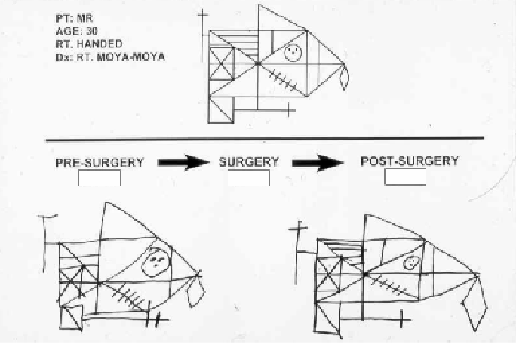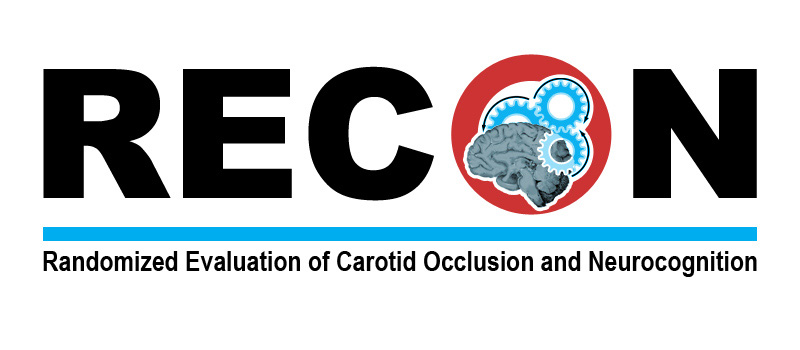|
| Background
and Significance |
OVERALL GOAL
To assess the relationship
between cerebral hemodynamics
and cognitive function in
patients undergoing treatment
for unilateral carotid artery
occlusion with extracranial-intracranial
(EC-IC) bypass in the Carotid
Occlusion Surgery Study (COSS).
SPECIFIC AIM
To determine whether patients
who have symptomatic, unilateral
carotid artery occlusion and
stage II cerebral hemodynamic
failure as measured by increased
oxygen extraction fraction (OEF)
on positron emission tomography
(PET) will have better cognitive
function following EC-IC bypass
compared with an identical group
of patients treated with best
medical therapy alone.
PRIMARY HYPOTHESIS
Among COSS patients who survive
stroke-free after 2 years,
hemisphere-specific and global
neurocognitive function will be
significantly better among
patients who have undergone
EC-IC bypass than those in the
medically-treated group.
SECONDARY HYPOTHESES
1.
Among COSS patients who survive stroke-free after 2 years, the subset of surgical patients with normal OEF as documented by the COSS 1-month post-operative PET will demonstrate greater improvements in neurocognitive function than those in the medically-treated group.
2.
At the 2-year time point,
cognitive change will correlate
with change in disability and
quality of life measures.
BACKGROUND
Cognitive impairment, cerebral
hypoperfusion, and relevance to
COSS.
The notion that cerebral
hypoperfusion due to carotid
artery disease can produce
cognitive impairment was first
proposed by Dr. C. Miller Fisher
in 1951, based on a necropsy
case of a man with a progressive
dementia who had bilateral
carotid artery occlusion (Fisher
1951). Based on this and
other cases, Fisher postulated
that both unilateral and
bilateral carotid occlusion can
produce a dementia state, and
proposed for the first time that
restoration of blood supply
could potentially reverse the
condition. Between 1951 and
1985, when the multi-center
EC/IC bypass collaborative study
group published a failure of the
bypass procedure to reduce
stroke risk (1985), many reports
appeared in the cerebrovascular
literature attempting to
correlate carotid occlusive
disease with cognitive
impairment.
Most evidence from that period
suggested that cognitive
impairment can occur with
carotid disease, independent of
cerebral infarction, and
regardless of whether there is
unilateral or bilateral disease.
(Bakker, Klijn et al. 2000; Rao
2001) Yamauchi showed that
among patients with unilateral
carotid disease both right and
left hemisphere functions were
impaired(Yamauchi, Fukuyama et
al. 1996). The possibility that
surgical revascularization could
improve cognitive function was
approached only in the form of
non-randomized case series,
however. No randomized clinical
trial has ever addressed the
question. Nielson et al, for
example, found that 23 of 33
patients undergoing EC-IC bypass
had impaired neurocognitive
scores preoperatively and were
improved at 3 months after
surgery. (Nielsen, Hojer-Pedersen
et al. 1986) In their series,
however, only the
left-hemisphere injured patients
showed impairment at baseline
and improvement with treatment.
No hemodynamic measures were
acquired in that study, and no
control population was
evaluated. In a similar case
series of 38 patients undergoing
EC-IC bypass, Drinkwater et al
found minor improvements in
neuropsychological tests of
processing speed and memory but
no global improvement. (Drinkwater,
Thompson et al. 1984) Again, no
cerebral hemodynamic data or
control data were provided.
Binder et al. compared 12 EC-IC
bypass surgery patients with 7
ICA occlusion patients treated
medically. Both the surgical and
medical groups improved on
neurobehavioral measures, but
there was no difference between
the 2 groups in cognitive status
2 months after surgery.
Longer-term outcomes were not
reported, and again, no
hemodynamics or control groups
were included. (Binder, Tanabe
et al. 1982) Younkin et al
evaluated CBF with a 133Xe
inhalation technique in a series
of 44 patients undergoing EC-IC
bypass. Neuropsychological
scores increased at 3 months and
further increased at 9
months.(Younkin, Hungerbuhler et
al. 1985) Despite the positive
long-term improvements in
neurocognition, however, CBF was
shown to increase to a maximum
at 3 months after the operation,
then decline to near
pre-operative levels by 9
months. The authors proposed
that the clinical improvements
were due to recovery from stroke
deficits and were not explained
by improved CBF, a conclusion
similarly reached in a study by
Meyer et al (Meyer, Lotfi et al.
1990). Finally, a single case
was reported by Tsuda et al, who
described global cognitive
impairment in a patient with an
occlusion in the left ICA
siphon.(Tsuda Y 1994) Following
left EC-IC bypass rCBF measured
by 123I-IMP Single Photon
Emission Tomography (123I-IMP
SPECT) was restored to nearly
normal levels over the course of
2 to 9 months. Improvement in
cognition occurred over the
first 2 months after bypass, and
the improvement was sustained
for 3 years. In sum, these data
are suggestive but not
conclusive as to whether
cerebral hemodynamic failure and
recovery correlates with
neurocognitive change.
With the refinement of positron
emission tomography (PET) in the
1980s, it became possible to
quantify cerebral hemodynamics
in terms of oxygen and glucose
utilization, and cerebral
autoregulatory capacity. (Olsen,
Larsen et al. 1983; Sette, Baron
et al. 1989; Powers 1991) Unlike
methods that measured cerebral
blood flow (CBF) alone, the
newer PET method allowed
functionally important
hypoperfusion resulting from
carotid occlusive disease to be
distinguished from hypoperfusion
due simply to reduced metabolic
demands of damaged (infarcted)
tissue. Using quantitative PET
methods, cerebral hemodynamic
status could be defined more
completely. Current hemodynamic
theory holds that as perfusion
pressure falls CBF is maintained
by autoregulatory vasodilation
of cerebral arterioles. When
cerebral perfusion pressure
falls low enough, as might occur
in some cases of severe, chronic
ICA stenosis or occlusion, the
arterioles maximally dilate.
This state is referred to as
“exhausted cerebrovascular
reserve,” and can be imaged by
PET as increased cerebral blood
volume relative to CBF
(increased CBV/CBF ratio). At
this so-called “stage-I”
hemodynamic failure,
pharmacological vasodilatory
challenge with acetazolamide
injection or CO2 inhalation
fails to dilate the arterioles
further and may be associated
with increased stroke risk. (Yonas,
Smith et al. 1993; Kuroda,
Houkin et al. 2001; Markus and
Cullinane 2001; Marshall, Rundek
et al. 2003) As perfusion
pressure falls further, CBF
begins to decrease and a
metabolic compensation occurs as
oxygen extraction fraction (OEF)
increases to maintain tissue
oxygen metabolism. This “stage
II” hemodynamic failure,
sometimes referred to as misery
perfusion (Baron, Bousser et al.
1981), is thought to represent a
vulnerable hemodynamic state in
which any further drop in
perfusion will produce ischemia.
Until recently, what had not
been established was whether
stage-II hemodynamic failure can
be shown to be associated with
cognitive impairment and whether
rescue from this state can
improve or preserve cognitive
function. Sasoh et al showed
that among 25 patients with mild
stroke or TIA, unilateral ICA or
MCA occlusion, and increased OEF
by PET, verbal IQ, performance
IQ and full scale IQ were all
impaired before EC-IC bypass.
Furthermore, the scores
significantly increased after
bypass(Sasoh, Ogasawara et al.
2003). Because of the
similarities in design to COSS,
this study supports the
likelihood that the RECON
patient population will behave
in a similar fashion. RECON now
provides the unique opportunity
to test these notions in a
randomized clinical trial.
Some additional support for the
idea that revascularization can
improve cognitive status can be
derived from studies assessing
cognition before and after
carotid endarterectomy (CE). In
a systematic review of the
literature, Lunn et al
categorized 16 of 28 studies as
demonstrating a benefit of CE
for cognitive improvement. (Lunn,
Crawley et al. 1999) A majority
of the positive studies were
conducted before 1984, however,
and few analyzed cerebral
hemodynamics directly. Recently,
Heyer et al showed that patients
undergoing endarterectomy
improved on some elements of
neuropsychometric testing,
including executive and motor
functions, but decreased or did
not improve on others.(Heyer,
Adams et al. 1998) No
hemodynamic measures were
assessed. In another study
Hillis et al showed that in
patients with high-grade carotid
stenosis, regional hypoperfusion
was associated with language
deficits or hemispatial neglect
for left and right hemisphere
stroke respectively, and that
return to normal MR perfusion
patterns after endarterectomy
was associated with improved
cognition. (Hillis, Wityk et al.
2002). In our own experience, we
have presented a case of a 30
year old man with right sided
large vessel occlusive disease (Moya
Moya) who underwent a
revascularization procedure in
the right hemisphere. He had
developed cognitive decline over
many years, including slow
processing speed, verbal and
visual-spatial memory impairment
and visual-spatial neglect.
Following right-sided
revascularization (frontal Burr
holes), his blood flow improved
by Single Photon Emission
Tomography (SPECT) and
performance on neurocognitive
tests improved as well,
particularly for tasks
traditionally associated with
right hemisphere function.
Figure 1 (below) shows the
improvement in copying of the
Rey Complex Figure, one of the
neuropsychological tests to be
included in the battery for this
protocol.
Figure 1

Like the EC-IC bypass studies, CE studies have varied widely in the
timing of cognitive assessment,
the specific neuropsychological
tests performed, and the use or
absence of control populations.
These variables are crucial to
determine whether there is truly
a physiological link between
cognitive impairment and
hemodynamic failure in carotid
occlusive disease. All of these
variables can be addressed in
the context of this partially
blinded, randomized, controlled
clinical trial.
The COSS trial.
The COSS trial is an NINDS-sponsored,
multicenter, randomized,
controlled clinical trial
designed to test the hypothesis
that surgical anastomosis of the
superficial temporal artery to
the middle cerebral artery
(EC-IC bypass) when added to the
best medical therapy can reduce
subsequent ipsilateral ischemic
stroke at 2 years in patients
with symptomatic internal
carotid artery (ICA) occlusion
and Stage II hemodynamic failure
as measured by increased oxygen
extraction fraction (OEF) on
positron emission tomography
(PET). (Grubb 2003) The primary
endpoint in the COSS trial is
subsequent ipsilateral fatal or
non-fatal stroke. Although
quality of life and functional
scales of activities of daily
living are analyzed as secondary
endpoints, no formal assessment
of cognitive function is made.
As
an ancillary study to the COSS
trial, RECON (Randomized
Evaluation of Carotid Occlusion
and Neurocognition) represents a
unique opportunity to conduct an
adequately-powered, randomized,
controlled clinical trial to
evaluate the role of hemodynamic
failure as an independent
determinant of cognitive
function in large vessel
disease. We hope to determine
not only whether chronic
cerebral hemodynamic failure is
associated with cognitive
impairment, but more
importantly, whether treatment
of hemodynamic failure can
improve cognitive function or
protect against further
cognitive decline. RECON
cognitive outcomes will be
assessed in patients who have
not reached COSS endpoints (ie,
no recurrent stroke) so that
recurrent stroke will not
confound the assessment of
cognitive status at the end of
the 2-year study period. In
addition, because COSS includes
a baseline PET scan to determine
OEF status, we will know the
patients’ hemodynamic status.
Finally, cognitive outcome
measures will be correlated with
the functional scales assessed
by COSS to verify the clinical
relevance of cognitive change.
Positive results in the RECON
study would be important for the
COSS trial because if COSS fails
to show the predicted 40%
reduction in recurrent stroke
rate at 2 years, the efficacy of
the EC/IC bypass may still be
demonstrated by virtue of its
ability to improve or preserve
cognitive function. This would
help to establish the important
principle that neurological
outcomes in carotid artery
disease should be considered
more that just recurrent stroke.
If both COSS and RECON have
positive results, COSS will not
only be supported, but bypass
may be viewed as having a
beneficial effect beyond
prevention of recurrent stroke,
to date the only primary outcome
measure used in carotid artery
treatment trials. Other
revascularization treatments for
carotid artery disease such as
extracranial and intracranial
stent-angioplasty,
encephalodural arterial
synangiosis (EDAS), and even
hypertensive therapy in acute
large vessel stroke may then be
evaluated for cognitive outcomes
as well.
|
